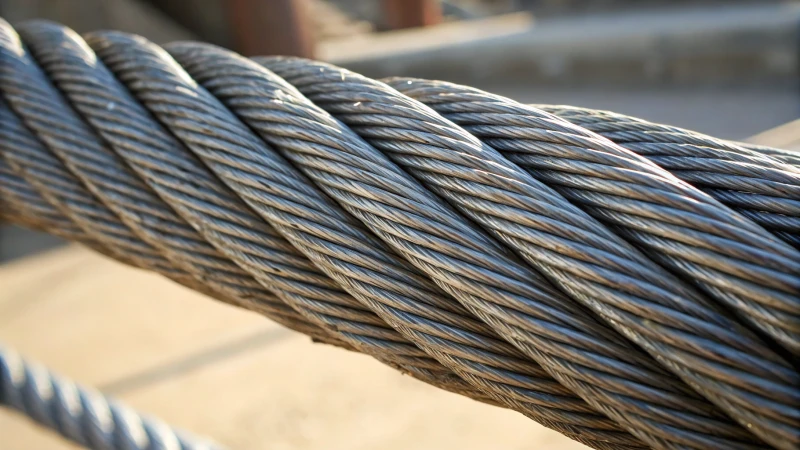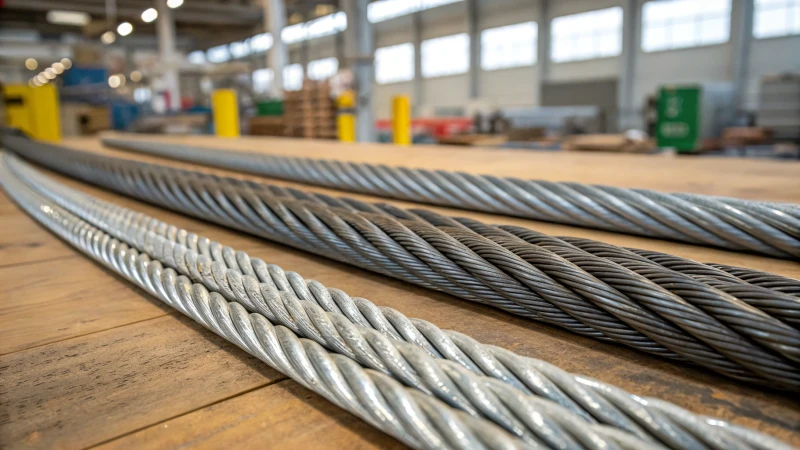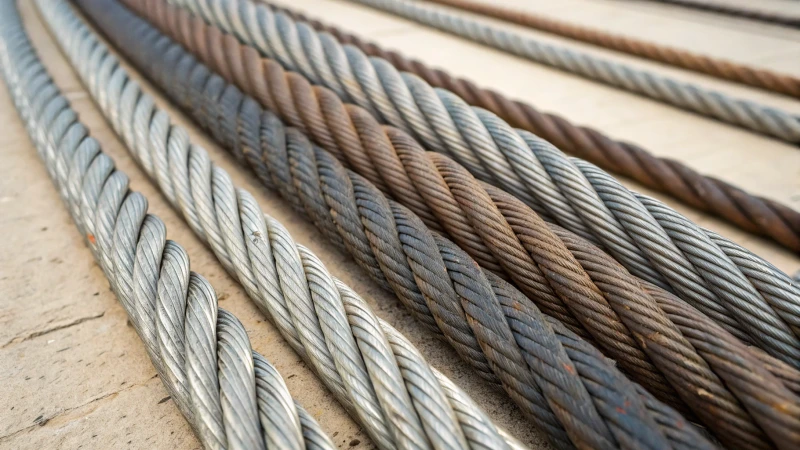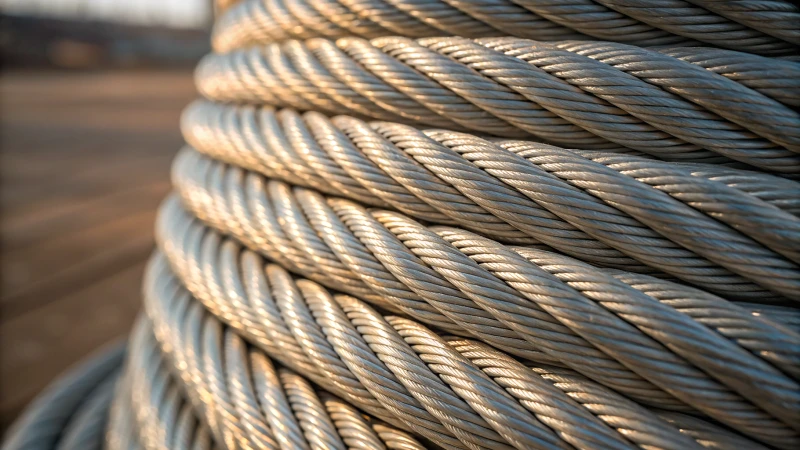
I remember the first time I had to choose the right steel wire rope for a project—it felt like unlocking a mystery! What really determines their strength?
The tensile strength of steel wire rope is influenced by material composition, construction type, weaving method, and diameter. High-strength alloy steels and specific constructions like 6×19 or 6×36 provide enhanced performance. Larger diameters typically offer greater load-bearing capacity. Understanding these factors is crucial for selecting the right rope for your application.
Digging deeper into each of these factors, it becomes clear that the choices you make are crucial. I once spent hours poring over specifications for a construction project, debating whether to go with a 6×19 or a 6×36 construction. The difference in flexibility and strength was significant enough to impact safety and efficiency on site. Each choice had its own story, shaped by the unique demands of the environment and equipment. Whether you're in construction, mining, or logistics, understanding these nuances helps you make informed decisions that enhance both procurement strategies and operational efficiency. It's like piecing together a puzzle where each element—material, design, size—interlocks perfectly to support colossal weights and ensure safety.
Material composition affects steel wire rope tensile strength.True
Different alloy compositions impact the strength and durability of the rope.
Smaller diameters provide greater load-bearing capacity.False
Larger diameters typically offer more load-bearing capacity than smaller ones.
How Does Material Composition Influence Wire Rope Strength?
Ever wondered why some wire ropes hold up like superheroes while others seem to snap under pressure?
Material composition impacts wire rope strength by determining its tensile capacity, corrosion resistance, and flexibility. High-strength alloys and stainless steel are preferred for optimal performance in demanding applications.

The Role of Material Composition in Wire Rope Strength
When I first stepped into the world of wire ropes, it was like navigating a complex web of choices, each with its own story of strength and resilience. Material composition, I quickly learned, is more than just a technical detail—it’s the heart of what makes wire ropes capable of enduring the toughest challenges. This choice affects tensile strength1, flexibility, and how well a rope stands up to wear and corrosion. Picking the right material isn't just a decision; it's ensuring the wire rope can bravely face the operational stresses of its environment.
Common Materials Used
-
Stainless Steel: I remember visiting a coastal construction site where stainless steel wire ropes were essential. Their reputation for excellent corrosion resistance makes them perfect for marine and outdoor settings where moisture is a constant adversary.
-
High-Strength Alloy Steels: In a conversation with a mining engineer, I realized how these steels are the backbone of environments demanding high load-bearing capacity due to their superior tensile strength.
Impact of Different Compositions
-
Carbon Content: A fellow engineer once explained to me over coffee that increasing carbon content can boost the strength2 and hardness of steel wire ropes but might sacrifice some ductility.
-
Alloying Elements: Adding elements like nickel or chromium can transform a rope’s properties, enhancing its corrosion resistance and toughness—a revelation shared by a seasoned metallurgist during a seminar.
Construction and Design Considerations
The design intricacies of wire ropes—like the number of strands and wires per strand—are fascinating. For instance:
-
6×19 Construction: Offers a balance between strength and flexibility, making it a versatile choice for general use.
-
6×36 Construction: Known for greater flexibility, though it trades off some strength, it's perfect when ropes need to wind around sheaves or pulleys.
Environmental Factors
I’ve learned that material choice should never overlook environmental conditions. Stainless steel is crucial in coastal areas to prevent rust, while galvanized ropes provide a budget-friendly option in less severe climates.
| Material | Key Properties |
|---|---|
| Stainless Steel | Corrosion resistant, durable |
| Alloy Steels | High tensile strength, heat resistant |
| Galvanized Steel | Affordable, moderate corrosion resistance |
Choosing the right material composition is like selecting the right tool for a job—it can significantly boost the performance3 and lifespan of wire ropes across various industrial applications.
Stainless steel wire ropes resist corrosion well.True
Stainless steel is known for excellent corrosion resistance, ideal for moist environments.
Higher carbon content reduces wire rope ductility.True
Increased carbon content enhances strength and hardness but lowers ductility.
How Does Construction Type Influence Tensile Strength?
Ever wondered how the very bones of a building or machine get their strength? Well, it all boils down to the construction type, especially when it comes to steel wire ropes.
Construction type significantly influences tensile strength by altering the flexibility and load-bearing capacity of steel wire ropes. Configurations like 6x19 and 6x36 adjust these properties, affecting performance in specific applications.

Construction Types and Their Impact on Tensile Strength
Let's break this down with a story. Picture yourself back in my first job as a procurement manager. I remember standing on a construction site, staring at these massive spools of steel wire ropes and wondering just how these wiry giants could hold up the weight of skyscrapers. That's when I learned about the magic of construction types.
For example, a 6x194 construction is like that reliable old friend who balances everything. It combines strength and flexibility, making it perfect for general-purpose use. I recall using this for projects where moderate flexibility was key, like when we had to navigate around corners or through complex structures.
On the other hand, there's 6x36, which is all about flexibility—ideal when you need to do some serious bending without losing strength. I once worked on a project where these ropes had to maneuver through tight spaces constantly; it was like watching a ballet of steel!
And then, there's the diameter—bigger means stronger but less nimble. Imagine trying to fold a thick winter coat compared to a light scarf. It’s all about finding that sweet spot depending on what the job calls for.
| Construction Type | Strength | Flexibility |
|---|---|---|
| 6x19 | Moderate | Moderate |
| 6x36 | Lower | Higher |
Material Composition
Now, material composition is another layer of this intricate puzzle. Think of it as the secret sauce. High-strength alloy steels bring more tensile strength than your standard options. And let's not forget stainless steel, like AISI 316—it’s the go-to for marine environments because it laughs in the face of corrosion. Check out more about stainless steel properties5 if you're curious.
Real-World Applications
Let me paint a picture from real life. In marine projects, I've seen how choosing the right rope makes all the difference—stainless steel with a 6x36 setup works wonders because of its blend of flexibility and corrosion resistance. Conversely, for those grueling construction site jobs6, a 6x19 galvanized rope stands out for its strength and balanced flexibility.
Understanding these nuances isn’t just technical know-how; it’s about making informed decisions that ensure safety and efficiency. Procurement managers like John and Emma count on these insights to pick the right tools for their unique challenges. After all, in our line of work, precision is everything.
6x19 wire ropes are more flexible than 6x36 ropes.False
6x19 ropes are less flexible than 6x36 due to fewer wires per strand.
Larger diameter ropes generally have higher tensile strength.True
Greater diameter increases load capacity, enhancing tensile strength.
Why Is Weaving Method Important for Wire Rope Durability?
Have you ever wondered why some wire ropes last longer and perform better than others in demanding environments?
The weaving method impacts a wire rope's flexibility, strength, and resistance to environmental factors. Different techniques, like cross-lay and parallel-lay, influence the rope's durability and its suitability for specific tasks.

Understanding Weaving Methods
I remember the first time I was tasked with selecting the right wire rope for a construction project. It felt like stepping into a maze of technical jargon. But then I discovered that the weaving method could make all the difference. Cross-lay ropes, for instance, weave strands at angles to each other, making them incredibly flexible—ideal for those intricate hoisting tasks where the rope needs to bend and twist without breaking a sweat. On the other hand, parallel-lay ropes boast a denser structure, which translates to remarkable strength but less flexibility. It's like choosing between a gymnast and a weightlifter—each excels in different arenas.
| Weaving Method | Benefits | Ideal Use Cases |
|---|---|---|
| Cross-lay | Flexibility, load distribution | Hoisting, lifting |
| Parallel-lay | Strength, abrasion resistance | Mining, construction machinery |
Importance in Construction and Mining
In construction, where I often need ropes that can dance around corners while lifting hefty loads, cross-lay ropes are my go-to. Their flexibility and ability to distribute load evenly make them indispensable for heavy-duty tasks. But when I shift my focus to mining operations, parallel-lay ropes7 become the hero of the day. With their superior tensile strength and resistance to wear, they can brave harsh environments without a hitch.
Environmental Considerations
One of my projects involved marine applications, where the salty air was a constant threat. The weaving method played a crucial role here too. Cross-lay ropes offered more corrosion resistance, extending their lifespan in this unforgiving environment. Understanding environmental impacts8 became vital in ensuring that I chose ropes that wouldn't just survive but thrive.
Selection Criteria for Procurement Officers
As a procurement officer, balancing factors like load-bearing capacity and environmental conditions is part of my daily routine. It's about finding that sweet spot between strength and flexibility, all while ensuring safety and efficiency. By keeping these criteria in mind, procurement officers9 like myself can make decisions that not only meet project needs but also keep timelines on track.
Cross-lay ropes are more flexible than parallel-lay ropes.True
Cross-lay weaving increases flexibility by allowing strands to move more freely.
Parallel-lay ropes are ideal for marine applications due to flexibility.False
Parallel-lay ropes prioritize strength over flexibility, less ideal for marine use.
How Does Diameter Influence Load-Bearing Capacity?
Ever wondered why some wires can hold up a skyscraper while others can't even handle a swing set?
The diameter of a structural element, like a steel wire rope, directly impacts its load-bearing capacity. Bigger diameters generally offer greater strength, making them perfect for heavy-duty applications.

The Science Behind Diameter and Load-Bearing
When I first got involved in procurement, I was amazed at how something as simple as diameter could make or break a project. Imagine you're holding a steel wire rope—its diameter is more than just a number; it's a testament to its power. In engineering terms, the diameter significantly affects the tensile strength10, which is the maximum stress that a material can withstand while being stretched. A larger diameter often means more material to distribute stress, boosting its load-bearing capacity.
Material and Structural Analysis
It's fascinating how different materials react to changes in diameter. I recall a project where we needed to choose between two steel rods with different diameters. While increasing the diameter generally enhances load capacity, factors like material composition and environmental conditions also come into play. In construction projects11, selecting the right diameter means balancing these elements to ensure safety and efficiency.
Practical Applications and Considerations
I remember working on a crane operation where the choice of steel wire rope was critical. A larger diameter rope could handle more weight, which was crucial for lifting heavy machinery. But it wasn't just about the weight it could hold; the rope itself became heavier, impacting mobility and speed.
| Diameter (inches) | Load-Bearing Capacity (tons) |
|---|---|
| 0.5 | 2 |
| 1.0 | 5 |
| 1.5 | 10 |
| 2.0 | 20 |
This table clearly shows how increasing the diameter enhances the load-bearing capacity. Yet, as engineers, we must also consider flexibility and specific applications12 of the rope.
Balancing Diameter with Other Factors
While focusing on diameter is essential, I learned early on that ignoring other factors like material properties13 and construction type can lead to oversight. For instance, a 6×36 wire rope offers different flexibility and strength characteristics compared to a 6×19 construction, even if their diameters are the same. Understanding these nuances is key to making informed decisions about the right materials for specific uses.
Larger diameters enhance tensile strength.True
More material in larger diameters increases tensile strength, enhancing load capacity.
Diameter is the only factor in load-bearing capacity.False
Material properties and environmental conditions also significantly affect load capacity.
Conclusion
Tensile strength of steel wire rope is affected by material composition, construction type, weaving method, and diameter, crucial for selecting the right rope for various applications.
-
Explore how tensile strength varies with different wire rope materials and compositions. ↩
-
Learn about the relationship between carbon content and the strength characteristics of steel wire ropes. ↩
-
Understand what factors contribute to the overall performance of wire ropes in industrial settings. ↩
-
Explore the benefits and applications of 6x19 wire rope construction to understand its balance between strength and flexibility. ↩
-
Learn about the properties of AISI 316 stainless steel to see why it’s favored in corrosive environments. ↩
-
Discover how different wire rope constructions are applied in construction sites for optimal performance. ↩
-
Explore this link to understand why parallel-lay ropes are preferred for high-strength applications. ↩
-
Learn how different environments affect wire rope longevity and performance. ↩
-
Discover key factors procurement officers should consider when selecting wire ropes. ↩
-
Understanding tensile strength helps readers grasp why diameter affects load capacity. ↩
-
Guides on choosing diameters offer practical insights for construction professionals. ↩
-
Exploring applications assists in comprehending how diameter selection varies by use. ↩
-
Material properties help determine how diameter influences overall strength. ↩

